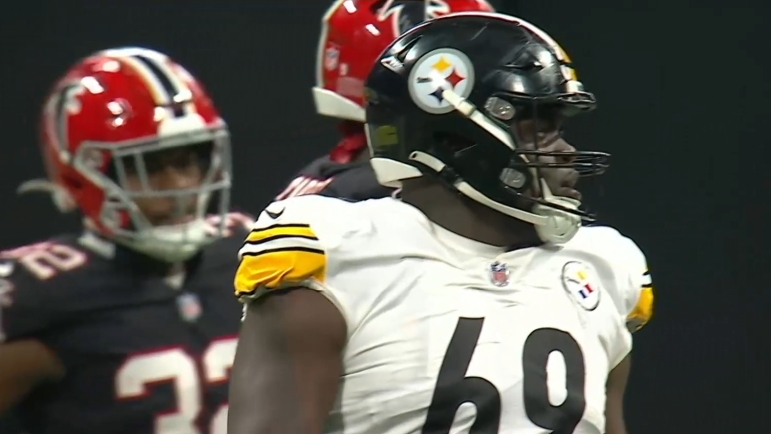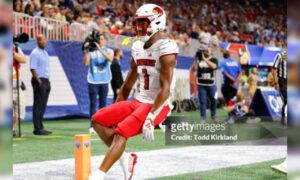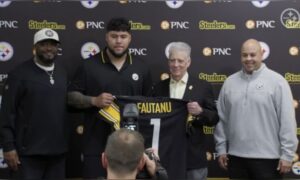Though it’s the focus of every outcome, NFL trades aren’t made in a vacuum. It’s not just a value-for-value equation. What I am giving versus what I am getting. If it was that simple, trades in football would probably be more common. But there’s another element to getting a deal done. Understanding the market. Supply and demand. The lower the supply, the higher the demand. In 18 months on the job, Omar Khan has used that to his advantage in the three most notable deals he’s swung. Trading WR Chase Claypool to the Chicago Bears, trading OL Kevin Dotson to the Los Angeles Rams, and trading OL Kendrick Green to the Houston Texans.
Chase Claypool – 2nd Round Pick
It’s still a shock to know Omar Khan got a second round pick out of Chase Claypool, who had no role and clearly worn out his welcome in Pittsburgh. Ten months after the deal, the Steelers still look like big winners. Claypool contributed little to the Bears’ offense and Chicago didn’t win a single game after acquiring him. Pittsburgh has better slot options in 2023 in Allen Robinson (traded for peanuts) and Calvin Austin III while using the Claypool pick to take CB Joey Porter Jr.
So why did Claypool have value? Two reasons. There was an element of team control with him, on his rookie deal through the 2023 season. Many trades are either rentals, players on expiring deals, or players who are traded and immediately sign long-term deals with their new team (which reduces compensation because the team is giving up compensation and paying a lot of money). Claypool was a middle ground. That helped, at least a little.
But the driving factor was the NFL’s concern over 2023 wide receiver free agent and receiver options. With so many receivers inked to long-term deals ahead of the 2022 season (Tyreek Hill, A.J. Brown, and Davante Adams’ trade-and-sign along with Stefon Diggs, Deebo Samuel, Terry McLaurin) coupled with a draft class that didn’t seem as top-heavy as usual. Ultimately, several receivers went in the first round but there was a late run at the position, the first off the board 20th overall.
Meaning, the Bears wanted an upgrade at receiver but were going to struggle to find it through the two main buckers of player acquisition, free agency and the draft. They had to turn to alternative routes and with few wide receivers being shopped at that time, it drove Claypool’s price up up. Again, supply met demand, and Claypool he go for that much (Chicago later traded for WR D.J. Moore from Carolina in a deal for the No. 1 pick, Moore’s inclusion being what got the deal done).
Khan was likely well-aware of all these facts and waited Bears’ GM Ryan Pole out to get the best offer possible. That’s how you get a second-round pick for a guy not worth that much. Had free agency and the draft class looked stronger, it’s doubtful Claypool would’ve fetched such a haul.
Kevin Dotson – 2024 and 2025 Pick Swaps
*Full trade details here, if you’re interested.
Dotson fell out of favor in Pittsburgh but it didn’t mean he lacked trade value. In later summer and around the cutdown deadline, no position is more valuable than offensive linemen. It’s the league’s scarcest position where most teams are lacking strong enough starters, let alone quality depth. The rare teams who have a surplus often cash out. Of the 24 players claimed off waivers the day after cutdowns, nearly 30 percent of them were offensive linemen.
That happened with Dotson. The Rams need help, probably a starting right guard but at the least, a quality backup, and that’s why they were interest with Dotson. Inconsistent as his play was, there’s aren’t a ton of experienced, young, and cheap linemen available. Khan leveraged that to get a good deal out of the Rams. It wasn’t a steal, it wasn’t Claypool-level but pick swaps for a rebuilding Rams team with a shoddy-looking roster (with WR Cooper Kupp’s Week One status in question) could mean a big swing when it comes to the actual compensation.
Kendrick Green – 2025 6th Rounder
Similar applies to Green as it did Dotson. Offensive linemen, even ones who have struggled as much as Green, still contain value. What’s different here is the Texans’ desperation. Slammed by injuries to multiple players, including former first round pick Kenyon Green and scheduled starting rookie center Juice Scruggs, the Texans had to make a last-second pivot to add names to the line.
With their demand high, Khan was able to convince them to take Green. While I can’t say with certainty, this deal likely materialized at the last second and the Texans’ suddenly wide-open-looking offensive line compelled them to send a 2025 sixth rounder. Despite Houston picking second in the waiver order, Khan played on that fear and desperation to get something for Green, who was not going to make the 53.
All three trades had slightly different components Khan leaned on. The future of free agency and draft classes, the scarcity of talent along o-lines, the desperation that comes when injuries crush a team. All three turned into good deals for Khan and good deals for the Steelers.








